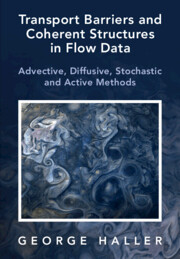 Transport Barriers and Coherent Structures in Flow Data
Transport Barriers and Coherent Structures in Flow Data Book contents
- Frontmatter
- Dedication
- Contents
- Preface
- Acknowledgments
- 1 Introduction
- 2 Eulerian and Lagrangian Fundamentals
- 3 Objectivity of Transport Barriers
- 4 Barriers to Chaotic Advection
- 5 Lagrangian and Objective Eulerian Coherent Structures
- 6 Flow Separation and Attachment Surfaces as Transport Barriers
- 7 Inertial LCSs: Transport Barriers in Finite-Size Particle Motion
- 8 Passive Barriers to Diffusive and Stochastic Transport
- 9 Dynamically Active Barriers to Transport
- Appendix
- References
- Index
7 - Inertial LCSs: Transport Barriers in Finite-Size Particle Motion
Published online by Cambridge University Press: 20 February 2023
- Frontmatter
- Dedication
- Contents
- Preface
- Acknowledgments
- 1 Introduction
- 2 Eulerian and Lagrangian Fundamentals
- 3 Objectivity of Transport Barriers
- 4 Barriers to Chaotic Advection
- 5 Lagrangian and Objective Eulerian Coherent Structures
- 6 Flow Separation and Attachment Surfaces as Transport Barriers
- 7 Inertial LCSs: Transport Barriers in Finite-Size Particle Motion
- 8 Passive Barriers to Diffusive and Stochastic Transport
- 9 Dynamically Active Barriers to Transport
- Appendix
- References
- Index
Summary
In this chapter, we will be concerned with barriers to the transport of inertial (i.e., small but finite-size) particles in a carrier fluid. As a general rule, the more the density of inertial particles diverts from the carrier fluid density, the more they tend to depart from fluid trajectories. Specifically, while small enough neutrally buoyant particles often remain close to fluid motion, the same is not true for heavy particles (aerosols) and light particles (bubbles). Practical flow problems involving inertial particles tend to be temporally aperiodic and hence the machinery of LCSs discussed in earlier chaptersis also highly relevant for inertial particles. By inertial LCSs (or iLCSs, for short), we mean coherent structures composed of distinguished inertial particles that govern inertial transport patterns. In contrast, LCSs (composed of distinguished fluid particles) govern fluid transport patterns. The purpose of this chapter is to examine how iLCSs differ from LCSs of the carrier fluid.
Keywords
- Type
- Chapter
- Information
- Transport Barriers and Coherent Structures in Flow DataAdvective, Diffusive, Stochastic and Active Methods, pp. 275 - 299Publisher: Cambridge University PressPrint publication year: 2023
